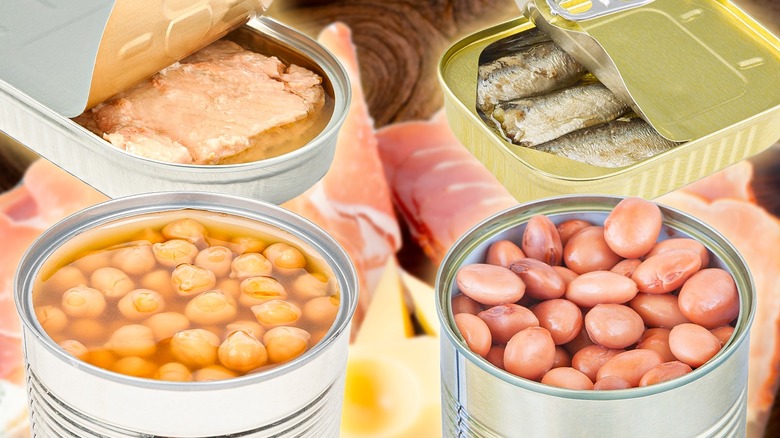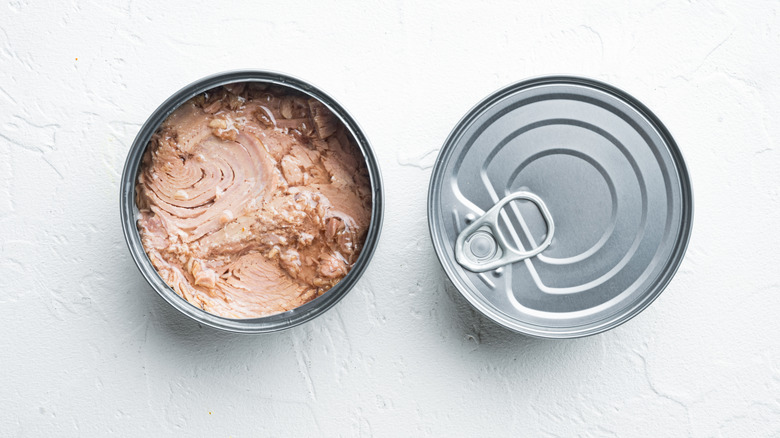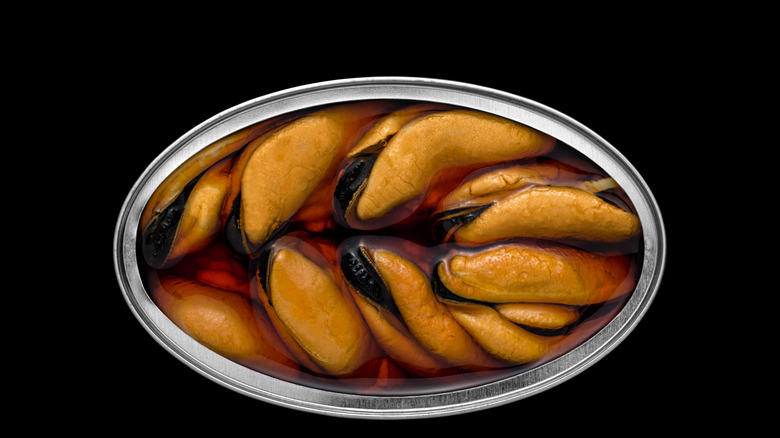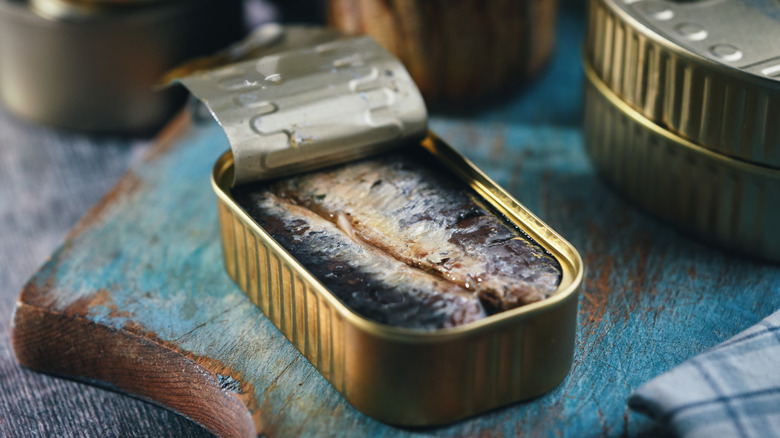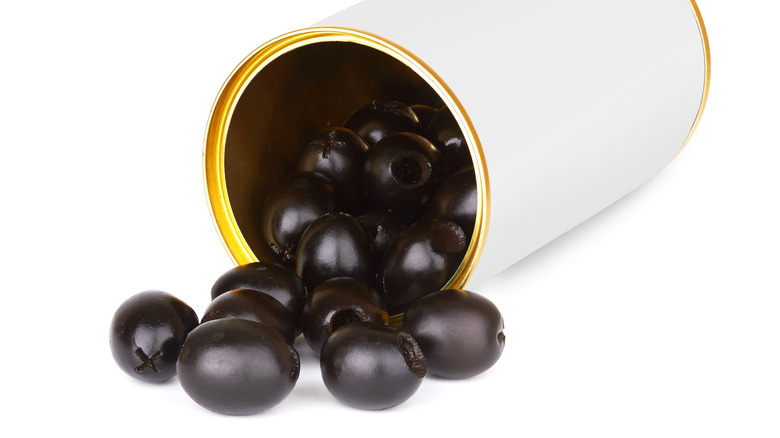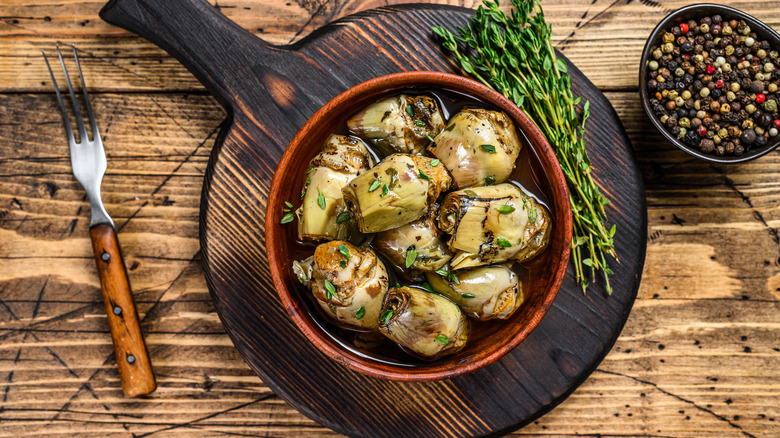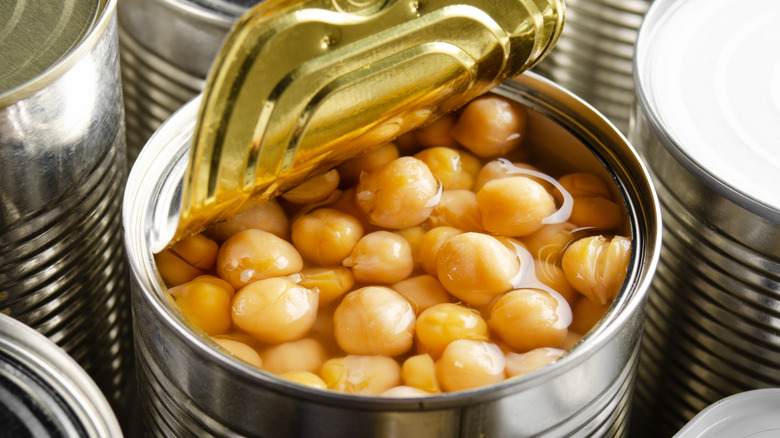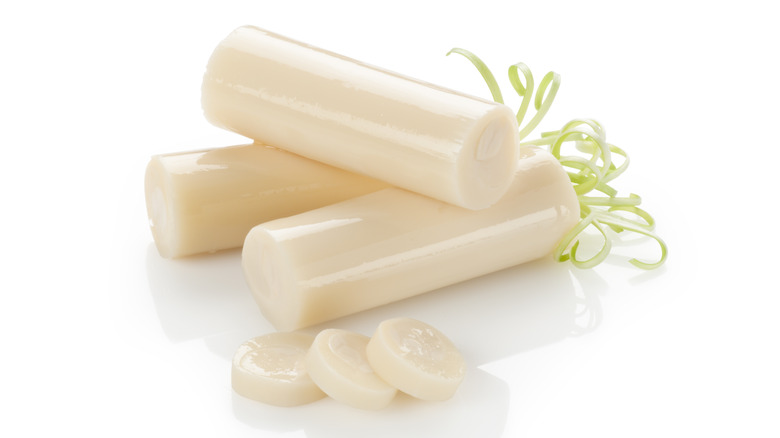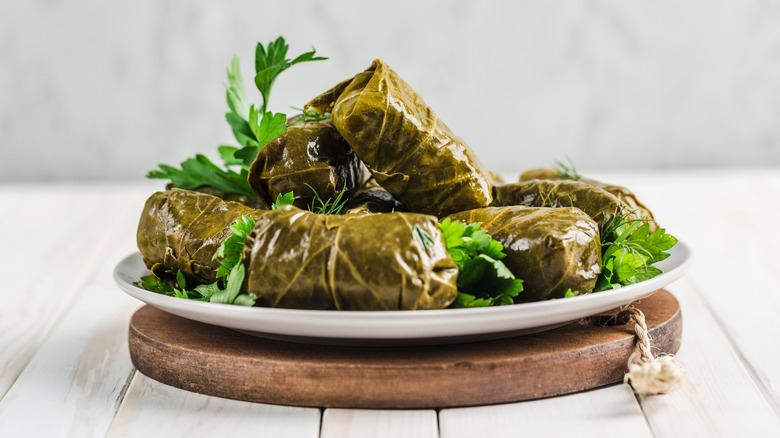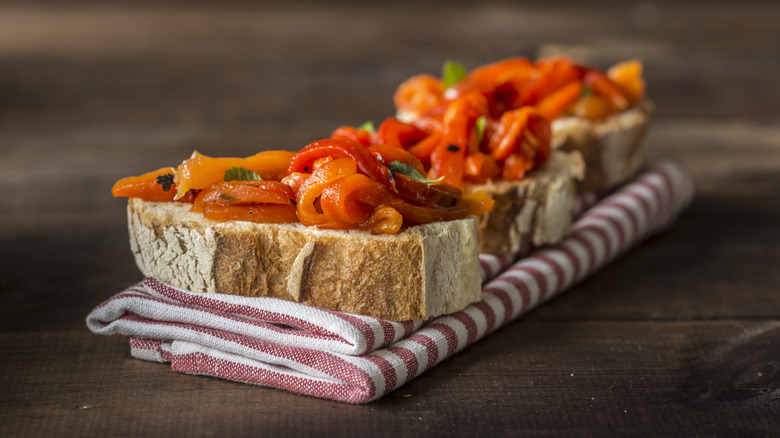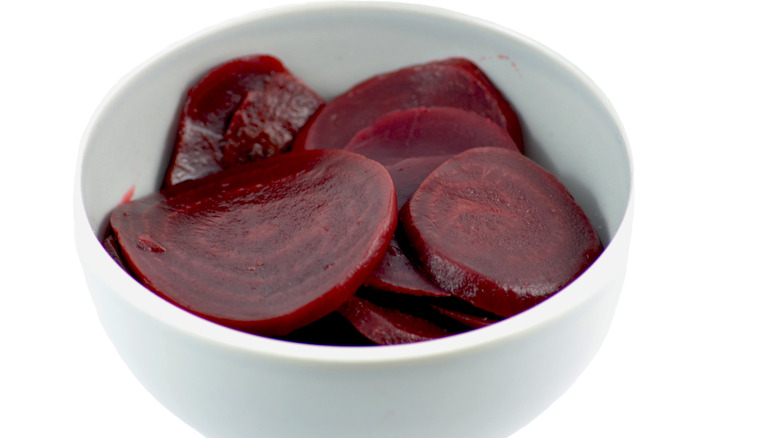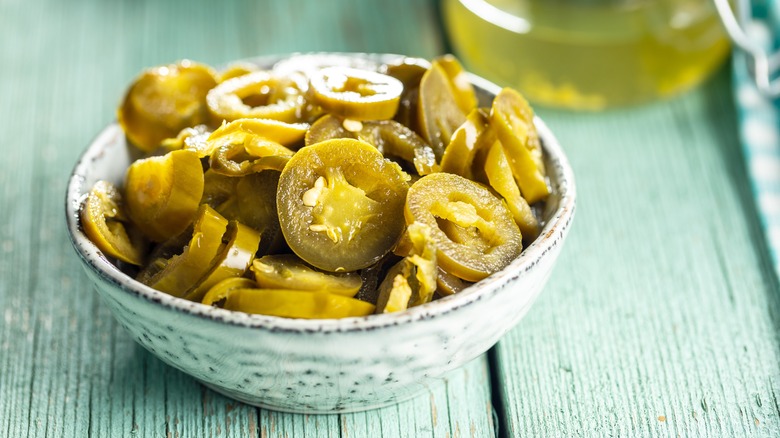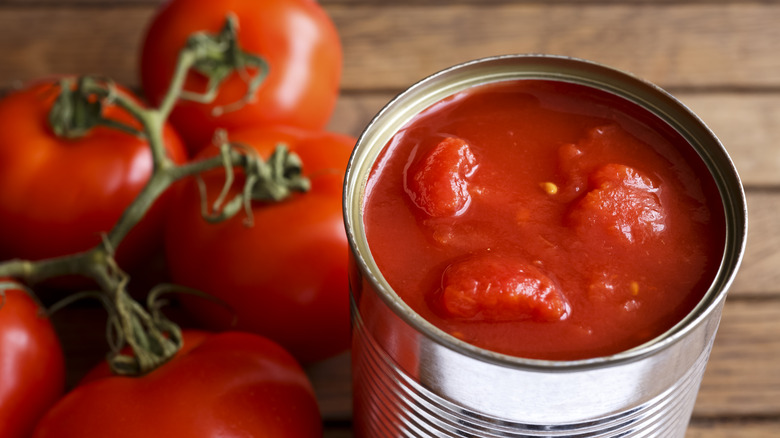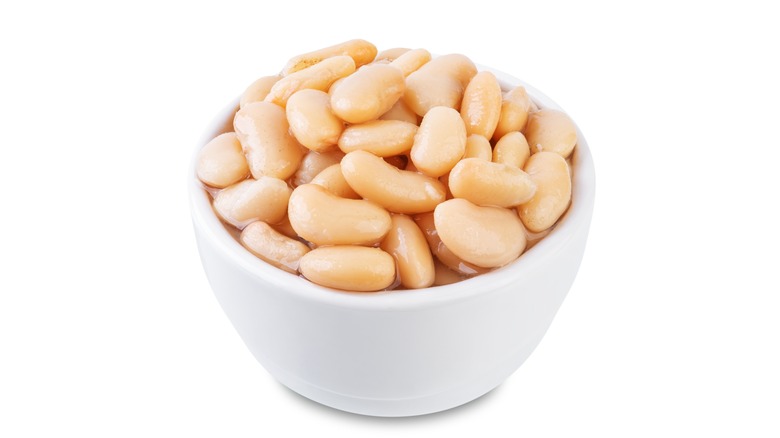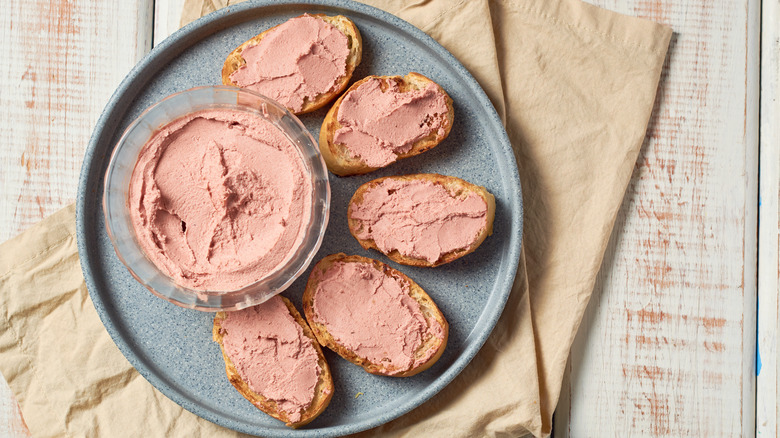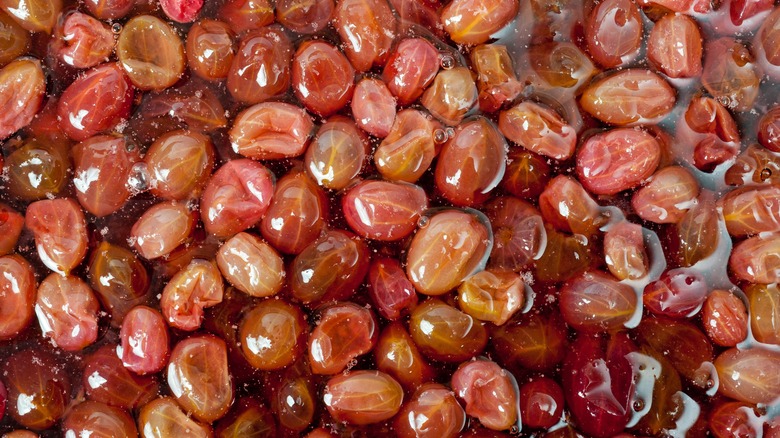16 Canned Foods That Belong On Your Next Charcuterie Board
Whether you call it a snack, "Girl Dinner," mezze, or "picky bits," charcuterie board-like meals — the ones we've all been eating and entertaining with for ages – have finally become embraced, verified, and legitimized thanks to TikTok and other forms of social media. This style of eating has always been popular in many cuisines across the world, adding variety to stimulate the palate alongside balance.
Charcuterie boards and charcuterie board styles of eating are a fantastic way to enjoy a wide variety of foods through a selection of meats, cheeses, crackers, and produce. Though it's often thought that fresh is best, we're here to champion the canned and tinned as viable, economical, and delicious options for your next charcuterie board. Canned ingredients are also brilliant time-savers, giving hosts the luxury of ease and a bit of extra time for selecting music, drinks, or just a bit of pre-entertaining pampering. Drawing from a number of cuisines, here are 16 canned ingredients to consider stocking up on for your next charcuterie board, snack, "Girl Dinner," or whatever you prefer to call it.
1. Canned tuna
Tinned fish of all kinds have been on the rise for the last few years. Chefs like Alison Roman have helped to popularize what has been a staple of European countries like Spain and Portugal: beautifully designed tins containing well-sourced seafood products. Brands like Fishwife have become fashionable to eat straight from the container or as part of a snack board. Tinned fish, including tuna, now have an unshakable presence, made even more popular thanks to TikTok and other social media platforms.
When adding this item to your charcuterie board, go for a higher-end, gourmet tinned tuna brand with a beautiful design if you plan to keep the fish in the tin. Choose one to have a fish section of the board, or skip the meat entirely and a few different cans to serve as a foundation, building your board from there with cheeses, pickles, crackers, or whatever else you fancy.
2. Canned salmon
When using a can of salmon on your next charcuterie board, there are equal opportunities for high or low presentations. Versatile, healthy, and wonderfully economical, it pays to keep a tin of salmon on hand for satisfying snacks, lunches, or fish-based additions to your next charcuterie board. The next time you feel the urge to reach for a can of tuna, try salmon instead. According to WebMD, this can also help to up your omega-3 fatty acid and vitamin D intake.
To make your canned salmon sing, mash it and add it to sour cream, lemon, and chives for a tasty dip. You can leave this dip chunky or throw it into the food processor or blender to create a smooth dip — similar in taste to a lox schmear. Change out the dairy for bread and add a squeeze of lemon to create a taramasalata-like dip – which is made from fish roe or fish eggs. Switch out the sour cream for cream cheese for an even more decadent, spreadable dip that would slot perfectly into an Ashkenazi-themed board with bagel chips, sliced red onions, and cucumbers.
3. Canned mussels
Don't let all the other tinned fish varieties hog the spotlight. There is plenty of room and appeal for a humble tin of mussels — smoked or unsmoked — on your next charcuterie board. In particular, Spanish mussels – gathered from the northwest region of Galicia — are known for their quality. "Conservas," a Spanish and Portuguese term referring to tinned fish and seafood such as mussels, is a pillar of both cuisines but can equally be embraced on American shores.
Tinned mussels can come in various forms, from wood-smoked to chili-marinated to varieties that come prepared escabeche-style — pickled or marinated in an acid-forward vinaigrette. There are plenty of mussel varieties, including fresh and salt water. Pick a few kinds. Then, toast and generously butter a loaf of good crusty bread, put out a seasoning salt or two, pour the wine, and tuck in — no need to overthink it.
4. Canned sardines or anchovies
Though we're not entirely sold on the nickname "seacuterie," the tinned fish trend — which initially took off in the United States during the pandemic — feels like it's here to stay. However, sardines, anchovies, and other types of small, oily tinned fishes have been celebrated in many Mediterranean cuisines and other food cultures long before this.
Whether you have a pretty-looking tin of oily fish or some smoked or marinated tinned fish products, you can simply open these tins up and place them directly on the charcuterie board. If that's not quite your style, try mashing a few sardines up and adding them to room-temperature butter for a savory cracker spread. You could also combine them with diced, crunchy vegetables for a texture-rich dip.
To take inspiration from the French, turn a tin of anchovies into a dip with garlic, olive oil, and salt, then spread it generously onto crusty bread. Or, skip the fuss and lay the anchovies whole alongside some aged cheese for a masterclass in umami flavors and rich textures. Chase with a side of vinegary-packed pickles for balance.
5. Canned black olives
Charcuterie boards of all kinds are an exercise in flavor balancing. Rich foods like cheeses and cured meats are balanced with acid. Soft foods are made all the more enjoyable when followed with something crunchy. Bright, citrusy, or vinegary foods pair beautifully with those ingredients that are dark, earthy, and rich, like black olives.
Add a bowl of onyx-coloured jewels to your next charcuterie board, served with toothpicks for plucking. You could also thinly slice or dice up half of a tin to mix with something briny like pickles or gherkins. Add a squeeze of lemon and a pinch of salt or a smattering of red chili flakes, and you now have the perfect topping, bursting with flavor, to spoon on top of crackers with saucisson or salami.
Thanks to an outbreak of botulism, black olives — their color signifying their ripeness — are always tinned for health and safety reasons. This makes them an excellent budget-friendly choice to pick up on your next trip to the grocery store for any impromptu entertaining that might involve a cheese or charcuterie board.
6. Canned artichokes
Fresh Globe artichokes are great, but for those looking for artichoke hearts without the work of having to peel through each layer and thistle, a can of artichoke hearts is calling you. Meaty, earthy, and super satisfying, we think canned artichokes might be the hero ingredient of your next charcuterie board.
You can do a million things with a tin of the stuff. Throw them onto or under a grill with some butter, then serve like you would sliced meats. Soak them in a punchy, herbaceous marinade — such as the juices from a jar of sun-dried tomatoes — to add balance to a charcuterie board filled with rich cheeses and meats. You can also blend canned artichokes with a hunk of cream cheese and a hint of acidity to turn them into a tasty dip for crudités. Are you looking to add a bit more crunch to your charcuterie board? Throw a tin of drained and well-seasoned artichokes into the air fryer for a crispy, almost caramelized treat guaranteed to please a crowd, especially when dunked into a creamy dipping sauce.
7. Canned chickpeas
Much like a good meal, the secret to a great charcuterie board is ensuring all satisfying textures and tastes are present and accounted for. Think sweet, savory, sour, creamy, and spicy. Then, combine those tastes with textures, including soft, chewy, and crunchy. A tin of chickpeas is so versatile it doesn't take long to come up with a great way to achieve any of these aesthetics, so you should keep a can on hand to help fill in any gaps necessary. These fiber and protein-rich legumes are also an excellent alternative for plant-based eaters.
Blend a tin with a heavy heaping of garlic, salt, lemon, and tahini to add a smooth and rich hummus to your board. Add in as many warming spices, like cumin, as you like, or serve with a jar of your favorite hot sauce and briny pickled vegetables for optimum flavor balancing. To add crunch and a satisfying snack appeal, try frying the chickpeas instead with plenty of garlic, spices, and salt.
8. Canned hearts of palm
For those looking to branch out and add new ingredients to their next charcuterie board, hearts of palm might be just the thing. Soft, supple yet firm, and mild, hearts of palm are ready to eat straight from the can. Hearts of palm are wonderful when sliced in rounds or lengthwise. You can season them with salt and pepper, lemon, or a drizzle of oil and vinegar. More recently, they've also been used as a meat-like alternative, thanks to their fibrous, almost meat-like texture when shredded or diced.
Though delicious, hearts of palm are not to be consumed in mass. Their production does require the harvesting from trees, which, if done too young — a last-ditch effort that's becoming more of a regular practice to compete with high demand — prevents the tree's re-growth, meaning this food is not the most sustainable. Therefore, moderation is vital, as is applying pressure to companies that advertise hearts of palm as low-carb substitutes in their products so that these companies don't drastically damage the environment.
9. Canned stuffed grape leaves
If it were up to us, we'd change Henry Ford's famous quote: "A Ford in every garage and a chicken in every pot" — as reported by TheClassicCars.com Journal — to include dolmas (stuffed grape leaves) instead of chicken. They are invaluable to pulling together a meal, snack, mezze, or charcuterie board in minutes.
Dolmas or dolmades, depending on the country of origin, are made from tender, fermented grape leaves. They are a traditional dish across many countries, including Greece, Turkey, and the Balkans. The grape leaves are folded to encase rice, vegetables, meats, and spices fillings. They are preserved with olive oil and often flavored with salt and lemon. Some versions will also contain legumes like chickpeas or pine nuts, so it's best to check the label to select the filling you prefer.
To add a can of dolmas to your next charcuterie board, consider deseeding a fresh pomegranate or drizzling with pomegranate molasses to garnish. Include a yogurt and lemon dipping sauce to make your grape leaves taste even better.
10. Canned roasted red peppers
A jar or can of roasted red peppers is magical; it can transform just about anything it touches in seconds, including the next charcuterie board you make. Once you have a few ways of using them in your back pocket, they will undoubtedly be a regular mainstay in your cupboard.
When adding some punch and pizzaz to a meat or cheese board, thinly sliced strips of roasted red peppers add much-needed acidity to mature hard cheeses, soft cheeses, and cured meats. Whiz a jar of roasted red pepper with walnuts, pomegranate molasses, and bread crumbs. You've got yourself muhammara dip — a fantastic Syrian dish for dipping breads, crackers, or crudités. Turn the chickpeas mentioned above into creamy hummus, add your roasted red pepper dip and a bowlful of meaty black olives, and just like that, a flavorful board (that also happens to be vegan) awaits you.
11. Canned beets
No matter what you're eating, adding visually striking pops of color — be it in salads, dips, or brightly colored vegetables — always adds appeal. It's no wonder the going advice regarding health is to eat the rainbow! Beetroot, whether the deep purple variety, golden-hued, or pink and white candy striped, is a simple and nutritious way to add rich flavor alongside a joyous pool of color to any charcuterie board. There is no need to stain your fingers purple or make your kitchen counter look like a murder scene by peeling the raw versions. There are various ways to incorporate canned beetroot into your next snacking board.
Try making bright and bold beetroot hummus by blending a can of drained beetroot with tahini, garlic, salt, and lemon until smooth. The zingy flavor is the perfect compliment to more decadent foods like cheeses and meats. You could also treat guests to diced beetroot-topped bruschettas, the earthiness of the beetroot playing against the sweet tomatoes (if not replacing them altogether). You can also use canned beetroot to create a show-stopping beet-pickled egg, whose hot pink outside and white and yellow centers feel as unique and precious as a Fabergé egg.
12. Canned pickled jalapeños
Heat or spice is one area of the flavor spectrum that can often be neglected in a charcuterie board. There's nothing like a little kick from smoked paprika or chili pepper to help enhance the creamy texture of a well-aged brie or make our palates appreciate other fatty foods.
Eating foods with capsaicin triggers the brain into thinking the mouth is hotter than it is. While most of us reach for a glass of water after adding too much hot sauce, this only spreads the capsaicin around. On the other hand, creamy, rich foods can help to cool it back down. One could argue garnishes like pickled jalapeños help our palates appreciate the richer foods found on charcuterie boards, as they work hand-in-hand to enhance each other's flavor profiles.
Add a can of pickled jalapeños or any heat-packed pepper to your next charcuterie board in several ways. Dice the peppers and add an equal amount of diced gherkins for a mouth-puckering, tastebud a-lighting garnish to top a thick slice of salami or aged cheddar. Alternatively, finely chop the jalapeños mix with cream cheese and shredded cheddar to create your own pimento cheese adjacent spread. You could also create a classic pimento cheese recipe, or even potato salad spread, and add the pickled jalapeños to give it extra oomph.
13. Canned tomatoes
Outside the confines of tomato sauce, stew, or a good ragu, canned tomatoes are some of the most overlooked non-perishable items on the shelf, especially when creating fresh-tasting dishes. Adding a tin of tomatoes, rather than fresh, in various ways onto your next charcuterie board is no exception; they're packed full of flavor and possibility! Tinned tomatoes, rather than fresh, are an economical, yet still delicious, substitute. They're also an earth-friendly substitution, working to reduce the carbon footprint made by purchasing imported tomatoes when the locally-grown varieties are out of season.
So, the next time you're craving bruschetta outside of tomato season, try replacing a would-be fresh tomato with a whole Roma tomato. We suggest roasting the tinned tomatoes first in the oven to intensify their flavor before dicing. Looking to add balance to richer foods with a fresh and bright homemade salsa? Reach for a can of fire-roasted tomatoes, and you'll find all the flavor you're looking for there, too.
14. Canned beans
Chef Michael Symon says beans are a secret weapon to level up your entertaining without breaking a sweat — or the bank. And if it's good enough for Michael Symon, it's good enough for us. Whether it takes the form of hummus, earthy black bean dip, or a lemony white bean spread, a can of beans, or several, are a must-have pantry ingredient for impromptu entertaining.
Canned beans were not made for just purees alone, however. They also soak up dressings and marinades incredibly well, so they are a valuable vehicle for adding acidity and balance to a rich charcuterie board. Add a few fresh vegetables and dressing alongside three varieties of canned beans to create a jalapeño-lime three-bean salad in no time. Or bulk out your favorite tin of tuna with a can of white beans, olive oil, and red wine vinegar for an Italian-inspired salad full of flavor and acidity to compliment any richer components to your next charcuterie board.
15. Canned pâté
Are you looking to have all the work done for you while still adding a bit of style to your next charcuterie board? The answer lies beneath the lid of a can of pâté. While many other ingredients on this list require a bit of finessing, this secret weapon of a charcuterie board component, the name of which is derived from the French word paste, has had all of the work done before it even hits your shopping cart. All you have to do is open, tip, or spoon it into a beautiful serving dish and serve.
Often made from pork, pâté pairs well with condiments that bring some acidity and a bit of sweetness. Chutneys, red onion jams, or tinned gooseberries make for a brilliant pairing that helps to simultaneously enhance and cut through the rich flavor and texture of the spread. You can, alternatively, make your own vegetarian version of the meaty spread at home.
16. Canned gooseberries
Throughout half of the 20th century, gooseberries were a no-go zone, not to be found stateside due to a federal banning. At the time, many gooseberry bushes were found to carry a tree-killing disease known as "white pine blister rust," but their temporary prohibition (lifted in 1966) did leave its impact. Unlike across the United Kingdom and parts of Europe, gooseberries are harder to come by in many areas of the U.S.
That said, consider this your call to action to seek them out, particularly in the canned section of the grocery store. According to Healthline, gooseberries are bursting with vitamin C and antioxidants. They also make lovely jams and chutneys. Like quince paste, this sweet-meets-sour combination is perfect for spreading onto soft cheeses like Brie, or harder cheeses like sharp cheddar cheese, manchego, or Comte. It even pairs well with hard salami when served with crackers. The balance of salty, rich flavors cut with the acidity and sweet-tart flavors make for a satisfying mouthful.
